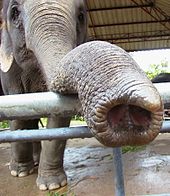Trunk finger
In zoology, the trunk fingers are called the appendages at the lower end of the elephant's trunk . In terms of fine motor skills, they serve as gripping tools . The number of trunk fingers is different for the individual elephant species:
The two species of African elephants ( steppe elephant , Loxodonta africana , and forest elephant , Loxodonta cyclotis ) each have two proboscis fingers that lie vertically on top of each other. Functionally, not anatomically, they are arranged in the manner of the human upper and lower lip. The Asian elephant ( Elephas maximus ) has only one trunk finger, which is functionally in the position of an upper lip.
The anatomical correspondence with regard to the proboscis fingers is one of the reasons, along with numerous other features, why the zoological system assigns the two African elephant species to one and the same genus ( Loxodonta ) and the Asian species to another ( Elephas ).
